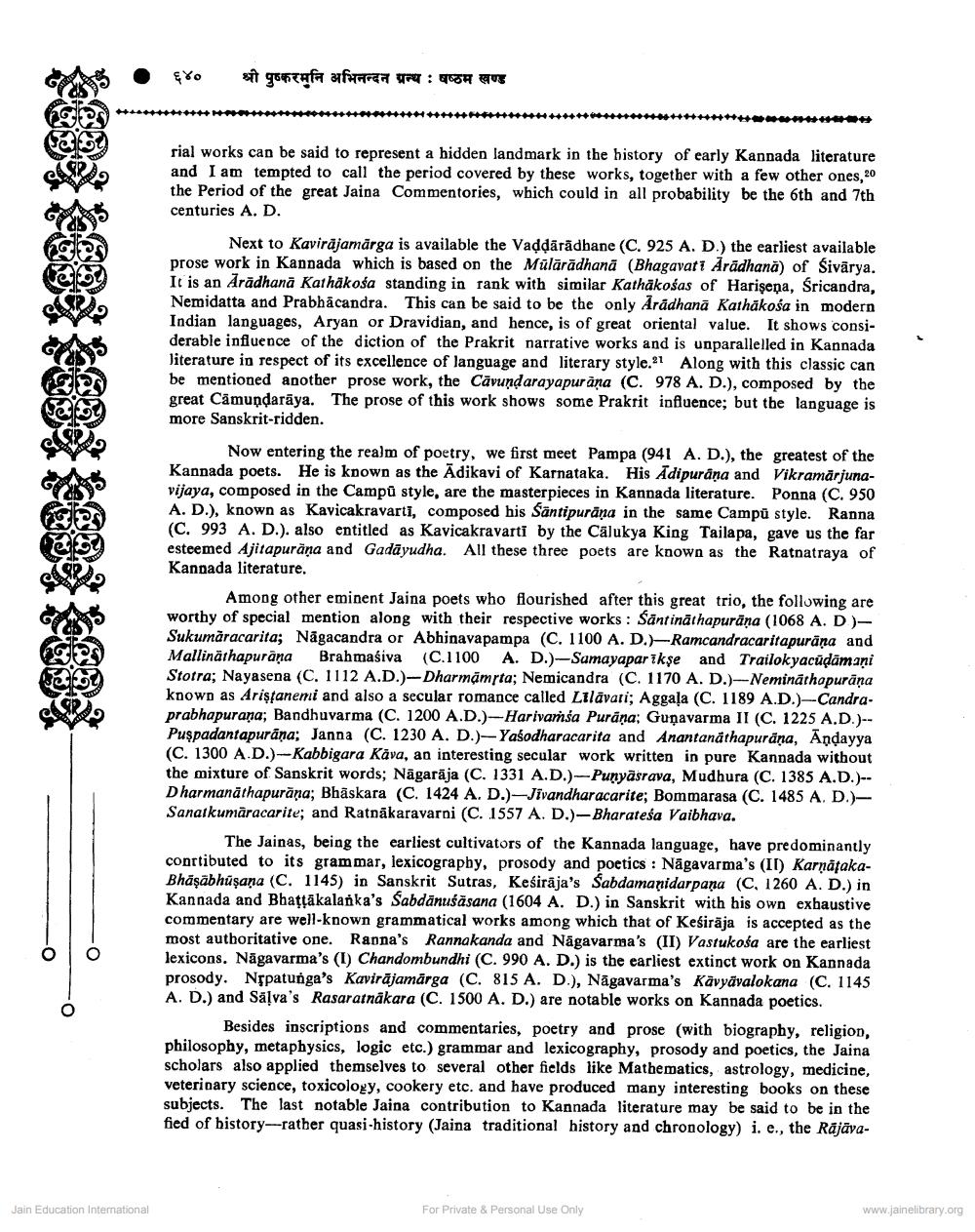________________
६४०
श्री पुष्करमुनि अभिनन्दन ग्रन्थ : षष्ठम खण्ड
rial works can be said to represent a hidden landmark in the history of early Kannada literature and I am tempted to call the period covered by these works, together with a few other ones 20 the Period of the great Jaina Commentories, which could in all probability be the 6th and 7th centuries A. D.
Next to Kavirajamärga is available the Vaddărădbane (C. 925 A. D.) the earliest available prose work in Kannada which is based on the Mülārādhanā (Bhagavati Arādhana) of Sivārya. It is an Arādhanā Kathākosa standing in rank with similar Kathäkośas of Harisena, Sricandra, Nemidatta and Prabhācandra. This can be said to be the only Aradhana Kathākośa in modern Indian languages, Aryan or Dravidian, and hence, is of great oriental value. It shows considerable influence of the diction of the Prakrit narrative works and is unparallelled in Kannada Jiterature in respect of its excellence of language and literary style. Along with this classic can be mentioned another prose work, the Cāvundarayapurana (C. 978 A. D.), composed by the great Camundarāya. The prose of this work shows some Prakrit influence; but the language is more Sanskrit-ridden.
Now entering the realm of poetry, we first meet Pampa (941 A. D.), the greatest of the Kannada poets. He is known as the Adikavi of Karnataka. His Adipuräna and Vikramärjunavijaya, composed in the Campu style, are the masterpieces in Kannada literature. Ponna (C. 950 A. D.), known as Kavicakravarti, composed his Säntipurāna in the same Campū style. Ranna (C. 993 A. D.). also entitled as Kavicakravarti by the Calukya King Tailapa, gave us the far esteemed Ajitapurăņa and Gadayudha. All these three poets are known as the Ratnatraya of Kannada literature.
Among other eminent Jaina poets who flourished after this great trio, the following are worthy of special mention along with their respective works : Santināthapurāna (1068 A. D)Sukumăracarita; Nāgacandra or Abhinavapampa (C. 1100 A. D.)-Ramcandracaritapuräna and Mallināthapurana Brahmaśiva (C.1100 A. D.)-Samayapar ikşe and Trailokyacūdāmaņi Stotra; Nayasena (C, 1112 A.D.)-Dharmamsta; Nemicandra (C. 1170 A. D.)--Nemināthapurāņa known as Aristanemi and also a secular romance called Lilāvati; Aggaļa (C. 1189 A.D.)--Candra. prabhapurana; Bandhuvarma (C. 1200 A.D.)-Harivañía Purāņa; Guņavarma II (C. 1225 A.D.)-- Puspadantapurāņa; Janna (C. 1230 A. D.)-Yaśodharacarita and Anantanathapuräna, Andayya (C. 1300 A.D.)--Kabbigara Kava, an interesting secular work written in pure Kannada without the mixture of Sanskrit words; Nāgarāja (C. 1331 A.D.)-Punyasrava, Mudhura (C. 1385 A.D.)-- Dharmanāthapuräna; Bhāskara (C. 1424 A. D.)-Jivandharacarite; Bommarasa (C. 1485 A. D.)Sanatkumāracarite; and Ratnākaravarni (C. 1557 A. D.)-Bharateśa Vaibhava.
The Jainas, being the earliest cultivators of the Kannada language, have predominantly conrtibuted to its grammar, lexicography, prosody and poetics : Nāgavarma's (ID) KarnatakaBhāşābhūşana (C. 1145) in Sanskrit Sutras, Kesirāja's Sabdamanidarpana (C, 1260 A. D.) in Kannada and Bhattākalanka's Sabdanuśasana (1604 A. D.) in Sanskrit with his own exhaustive commentary are well-known grammatical works among which that of Keśirāja is accepted as the most authoritative one. Ranna's Rannakanda and Nagavarma's (II) Vastukośa are the earliest lexicons. Nāgavarma's (1) Chandombundhi (C. 990 A. D.) is the earliest extinct work on Kannada prosody. NŢpatunga's Kavirājamārga (C. 815 A. D.), Nāgavarma's Kavyāvalokana (c. 1145 A. D.) and Sälva's Rasaratnakara (C. 1500 A. D.) are notable works on Kannada poetics.
Besides inscriptions and commentaries, poetry and prose (with biography, religion, philosophy, metaphysics, logic etc.) grammar and lexicography, prosody and poetics, the Jaina scholars also applied themselves to several other fields like Mathematics, astrology, medicine, veterinary science, toxicology, cookery etc. and have produced many interesting books on these subjects. The last notable Jaina contribution to Kannada literature may be said to be in the fied of history--rather quasi-history (Jaina traditional history and chronology) i. e., the Räjäva
Jain Education International
For Private & Personal Use Only
www.jainelibrary.org




